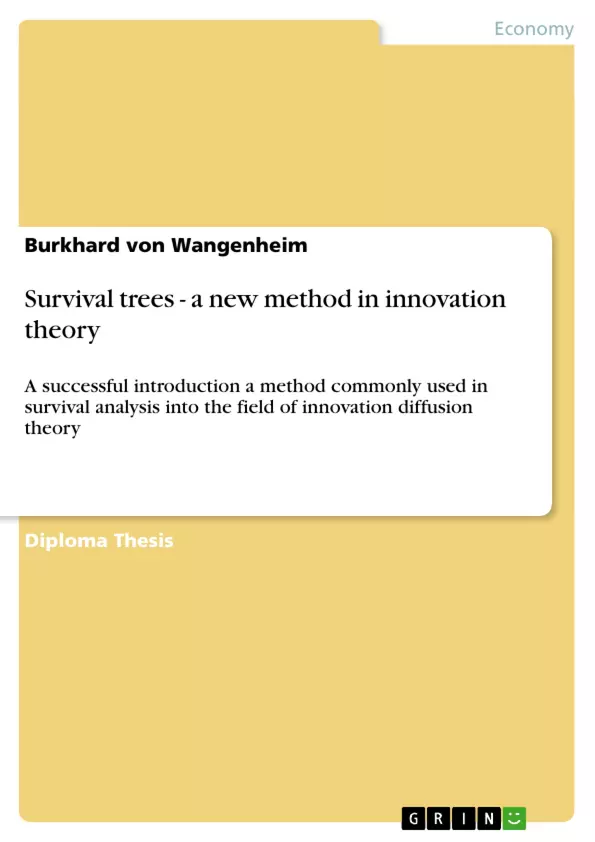
Survival trees - a new method in innovation theory
Diplomarbeit, 2004
101 Seiten, Note: 1,0
Leseprobe
Inhaltsverzeichnis (Table of Contents)
- 1 Introduction
- 1.1 Context of Thesis
- 1.2 Contribution of Thesis
- 1.3 Structure & Internal Pattern of Thesis
- 2 Modelling Censored Event Data in the Context of Innovation Adoption- and Diffusion Theory
- 2.1 Analysing and Forecasting Innovation Diffusion by Dynamic Micro Models
- 2.2 General Concepts and Terminologies
- 2.3 Statistical Framework
- 2.4 Classical Methods for the Analysis of Event History Data
- 2.4.1 Non-Parametric Methods
- 2.4.2 Parametric Methods
- 2.4.3 Semi-Parametric Methods
- 3 Presentation and Analysis of the Survival Tree Method
- 3.1 Review of CARTTM
- 3.2 Principle Framework & Mechanics of Survival Trees
- 3.3 Splitting, Pruning, Tree-Selection & Alternative Proposals for Survival Trees
- 3.3.1 Splitting - Growing the Saturated Tree
- 3.3.2 Pruning - Generation of Optimal Subtree Sequence
- 3.3.3 Final Tree Selection
- 3.3.4 Alternative Approaches
- 3.4 Final Assessment
- 3.4.1 Assessment of the Splitting, Pruning and Tree Selection Proposals
- 3.4.2 Merits & Deficiencies of the Survival Tree Method
- 4 The use of Survival Trees to Forecast Innovation Diffusion
- 4.1 Applicability of Available Software
- 4.2 Data Description & Handling
- 4.3 Implementation
- 4.4 Results
- 4.5 Discussion
- 5 Summary
Zielsetzung und Themenschwerpunkte (Objectives and Key Themes)
This thesis aims to contribute to the field of innovation diffusion by providing a comprehensive framework for analyzing and forecasting the adoption of new technologies using survival trees. The work seeks to address the limitations of traditional aggregate models and provide a micro-level approach to understanding individual adoption decisions.
- The importance of innovation diffusion in fostering economic growth and competitiveness
- The limitations of existing diffusion models in capturing individual adoption decisions
- The application of survival trees as a powerful tool for analyzing and forecasting innovation diffusion
- The empirical implementation of survival trees to forecast e-purchase adoption
- The implications of the findings for innovation management and policy
Zusammenfassung der Kapitel (Chapter Summaries)
Chapter 1: Introduction This chapter introduces the thesis and provides context for the research. It discusses the significance of innovation diffusion for economic growth and highlights the limitations of existing diffusion models.
Chapter 2: Modelling Censored Event Data in the Context of Innovation Adoption- and Diffusion Theory This chapter provides a detailed overview of the theoretical framework for analyzing and forecasting innovation diffusion. It discusses the key concepts and methodologies used in event history analysis, including both parametric and non-parametric methods.
Chapter 3: Presentation and Analysis of the Survival Tree Method This chapter presents the survival tree method as a powerful tool for analyzing innovation diffusion. It discusses the principles and mechanics of survival trees, including splitting, pruning, and tree selection. The chapter also assesses the strengths and weaknesses of the method.
Chapter 4: The use of Survival Trees to Forecast Innovation Diffusion This chapter demonstrates the practical application of survival trees in forecasting innovation diffusion. It describes the data used in the study and the implementation of the survival tree model. The results of the analysis are presented and discussed in relation to the theoretical framework.
Schlüsselwörter (Keywords)
The primary keywords and focus topics of this work include: innovation diffusion, survival trees, event history analysis, censored event data, dynamic micro models, technology adoption, e-purchase adoption, economic growth, competitiveness, and innovation management.
Details
- Titel
- Survival trees - a new method in innovation theory
- Untertitel
- A successful introduction a method commonly used in survival analysis into the field of innovation diffusion theory
- Hochschule
- Humboldt-Universität zu Berlin (Wirtschaftswissenschaften)
- Note
- 1,0
- Autor
- Burkhard von Wangenheim (Autor:in)
- Erscheinungsjahr
- 2004
- Seiten
- 101
- Katalognummer
- V193797
- ISBN (eBook)
- 9783656190943
- ISBN (Buch)
- 9783656191667
- Dateigröße
- 3387 KB
- Sprache
- Englisch
- Schlagworte
- using survival trees forecast innovation diffusion
- Produktsicherheit
- GRIN Publishing GmbH
- Preis (Ebook)
- US$ 36,99
- Preis (Book)
- US$ 47,99
- Arbeit zitieren
- Burkhard von Wangenheim (Autor:in), 2004, Survival trees - a new method in innovation theory, München, Page::Imprint:: GRINVerlagOHG, https://www.diplomarbeiten24.de/document/193797
- Autor werden
- Ihre Optionen
- Vertriebskanäle
- Premium Services
- Autorenprofil
- Textarten und Formate
- Services für Verlage, Hochschulen, Unternehmen

- © GRIN Publishing GmbH.
- Alle Inhalte urheberrechtlich geschützt. Kopieren und verbreiten untersagt.
- info@grin.com
- AGB
- Open Publishing
Der GRIN Verlag hat sich seit 1998 auf die Veröffentlichung akademischer eBooks und Bücher spezialisiert. Der GRIN Verlag steht damit als erstes Unternehmen für User Generated Quality Content. Die Verlagsseiten GRIN.com, Hausarbeiten.de und Diplomarbeiten24 bieten für Hochschullehrer, Absolventen und Studenten die ideale Plattform, wissenschaftliche Texte wie Hausarbeiten, Referate, Bachelorarbeiten, Masterarbeiten, Diplomarbeiten, Dissertationen und wissenschaftliche Aufsätze einem breiten Publikum zu präsentieren.
Kostenfreie Veröffentlichung: Hausarbeit, Bachelorarbeit, Diplomarbeit, Dissertation, Masterarbeit, Interpretation oder Referat jetzt veröffentlichen!
- GRIN Verlag GmbH
-
- Nymphenburger Str. 86
- 80636
- Munich, Deutschland
- +49 89-550559-0
- +49 89-550559-10
- info@grin.com
-









